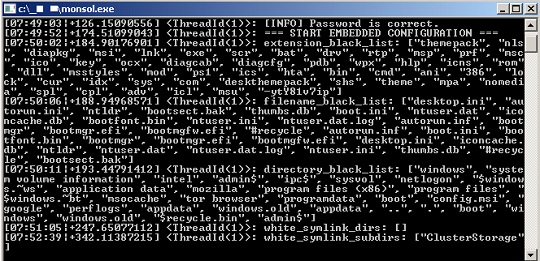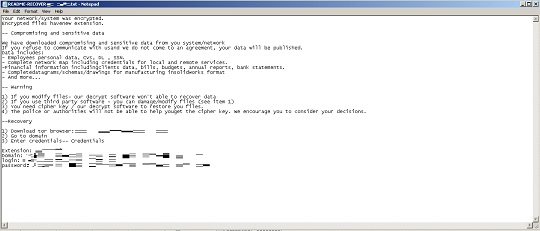Ransom.Win32.AGENDA.C
UDS:Trojan-Ransom.Win32.Qilin.ah (KASPERSKY)
Windows


Threat Type: Ransomware
Destructiveness: No
Encrypted: Yes
In the wild: Yes
OVERVIEW
This Ransomware arrives on a system as a file dropped by other malware or as a file downloaded unknowingly by users when visiting malicious sites.
It drops files as ransom note. It avoids encrypting files with the following file extensions.
TECHNICAL DETAILS
Arrival Details
This Ransomware arrives on a system as a file dropped by other malware or as a file downloaded unknowingly by users when visiting malicious sites.
Installation
This Ransomware drops the following files:
- %User Temp%\QLOG\ThreadId(number).LOG.txt → logs execution status

It adds the following processes:
- {malware filepath}/{malware filename} --password {string} --escalated --parent-sid {SID}
- "cmd" /C fsutil behavior set SymlinkEvaluation R2R:1
- "cmd" /C fsutil behavior set SymlinkEvaluation R2L:1
- "cmd" /C net use
- "cmd" /C wmic service where name='vss' call ChangeStartMode Manual
- "cmd" /C net start vss
- "cmd" /C vssadmin.exe delete shadows /all /quiet
- "cmd" /C net stop vss
- "cmd" /C wmic service where name='vss' call ChangeStartMode Disabled
- "powershell" $logs = Get-WinEvent -ListLog * | Where-Object {$_.RecordCount} | Select-Object -ExpandProperty LogName ; ForEach ( $l in $logs | Sort | Get-Unique ) {[System.Diagnostics.Eventing.Reader.EventLogSession]::GlobalSession.ClearLog($l)}
It creates the following folders:
- %User Temp%\QLOG
(Note: %User Temp% is the current user's Temp folder, which is usually C:\Documents and Settings\{user name}\Local Settings\Temp on Windows 2000(32-bit), XP, and Server 2003(32-bit), or C:\Users\{user name}\AppData\Local\Temp on Windows Vista, 7, 8, 8.1, 2008(64-bit), 2012(64-bit) and 10(64-bit).)
Other System Modifications
This Ransomware modifies the following registry keys:
HKEY_LOCAL_MACHINE\SOFTWARE\Microsoft\
Windows\CurrentVersion\Policies\
System
EnableLinkedConnections = 1
HKEY_LOCAL_MACHINE\SYSTEM\ControlSet001\
services\LanmanServer\Parameters
MaxMpxCt = 65535
Process Termination
This Ransomware terminates the following services if found on the affected system:
- vmms
- mepocs
- memtas
- veeam
- backup
- vss
- sql
- msexchange
- sophos
- msexchange\$
- wsbexchange
- pdvfsservice
- backupexecvssprovider
- backupexecagentaccelerator
- backupexecagentbrowser
- backupexecdivecimediaservice
- backupexecjobengine
- backupexecmanagementservice
- backupexecrpcservice
- gxblr
- gxvss
- gxclmgrs
- gxcvd
- gxcimgr
- gxmmm
- gxvsshwprov
- gxfwd
- sapservice
- sap
- sap\$
- sapd\$
- saphostcontrol
- saphostexec
- qbcfmonitorservice
- qbdbmgrn
- qbidpservice
- acronisagent
- veeamnfssvc
- veeamdeploymentservice
- veeamtransportsvc
- mvarmor
- mvarmor64
- vsnapvss
- acrsch2svc
- (.*?)sql(.*?)
It terminates the following processes if found running in the affected system's memory:
- vmms
- vmwp
- vmcompute
- agntsvc
- dbeng50
- dbsnmp
- encsvc
- excel
- firefox
- infopath
- isqlplussvc
- sql
- msaccess
- mspub
- mydesktopqos
- mydesktopservice
- notepad
- cautoupds
- ocomm
- ocssd
- onenote
- oracle
- outlook
- powerpnt
- sqbcoreservice
- steam
- ynctime
- tbirdconfig
- thebat
- thunderbird
- visio
- winword
- wordpad
- xfssvccon
- bedbh
- vxmon
- benetns
- bengien
- pvlsvr
- beserver
- raw_agent_svc
- vsnapvss
- cagservice
- qbidpservice
- qbdbmgrn
- qbcfmonitorservice
- sap
- teamviewer_service
- teamviewer
- tv_w32
- tv_x64
- cvmountd
- cvd
- cvfwd
- cvods
- saphostexec
- saposcol
- sapstartsrv
- avagent
- avscc
- dellsystemdetect
- enterpriseclient
- veeamnfssvc
- veeamtransportsvc
- veeamdeploymentsvc
- mvdesktopservice
Information Theft
This Ransomware gathers the following data:
- Hostname
- Username
Other Details
This Ransomware does the following:
- It requires the correct password to proceed in its intended routine.
- It terminates itself if it detects that the sample is being executed in a virtual environment.
- It uses the CPUID assembly instruction to check if the sample is being executed in a virtual machine.
- The company ID in the ransom note is the same as the extension that it wil append to enrypted files.
- It encrypts local and shared/network drives.
- Impersonates the privileges of the following process:
- lsass.exe
- winlogon.exe
- wininit.exe
- It logs its activities in a console.

It accepts the following parameters:
- --password {string} → password to enter before proceeding with its intended routine
- --paths {directory} → defines the path that parses directories; if this flag is used and left empty, all directories will be scanned
- --ips {IP address} → allows providing of ip addresses
- --excludes {directory} → exclude directory for encryption
- --timer → time delay before execution
- --no-sandbox → disable sandbox detection
- --no-escalate → execute without admin privileges
- --impersonate
- --safe → execute in safe mode
- --no-local
- --no-domain
- --no-network
- --no-ef
- --no-ff
- --no-df
- --no-proc
- --no-services
- --no-vmkill-cluster
- --no-extension
- --no-wallpaper
- --no-note
- --no-delete
- --no-destruct
- --no-zero
- --print-image
- --print-delay
- --force
- --spreads
- --debugspread
- --spread-vcenter
- --dry-run
- --escalated
- --parent-sid
- --spread-process
Ransomware Routine
This Ransomware avoids encrypting files with the following strings in their file name:
- desktop.ini
- autorun.ini
- ntldr
- bootsect.bak
- thumbs.db
- boot.ini
- ntuser.dat
- iconcache.db
- bootfont.bin
- ntuser.ini
- ntuser.dat.log
- autorun.inf
- bootmgr
- bootmgr.efi
- bootmgfw.efi
- #recycle
It avoids encrypting files with the following strings in their file path:
- .
- ..
- windows
- system volume information
- intel
- admin$
- ipc$
- sysvol
- netlogon
- $windows.~ws
- application data
- mozilla
- program files (x86)
- program files
- $windows.~bt
- msocache
- tor browser
- programdata
- boot
- config.msi
- perflogs
- appdata
- windows.old
- $recycle.bin
It renames encrypted files using the following names:
- {original filename}.{original file extension}.ytY81v7ip.1
It drops the following file(s) as ransom note:
- {All available directories}/README-RECOVER-ytY81v7ip.txt

It avoids encrypting files with the following file extensions:
- themepack
- nls
- diapkg
- msi
- lnk
- exe
- scr
- bat
- drv
- rtp
- msp
- prf
- msc
- ico
- key
- ocx
- diagcab
- diagcfg
- pdb
- wpx
- hlp
- icns
- rom
- dll
- msstyles
- mod
- ps1
- ics
- hta
- bin
- cmd
- ani
- 386
- lock
- cur
- idx
- sys
- com
- deskthemepack
- shs
- theme
- mpa
- nomedia
- spl
- cpl
- adv
- icl
- msu
- -ytY81v7ip
SOLUTION
Step 1
Trend Micro Predictive Machine Learning detects and blocks malware at the first sign of its existence, before it executes on your system. When enabled, your Trend Micro product detects this malware under the following machine learning name:
- Troj.Win32.TRX.XXPE50FFF077
Step 2
Before doing any scans, Windows 7, Windows 8, Windows 8.1, and Windows 10 users must disable System Restore to allow full scanning of their computers.
Step 3
Note that not all files, folders, and registry keys and entries are installed on your computer during this malware's/spyware's/grayware's execution. This may be due to incomplete installation or other operating system conditions. If you do not find the same files/folders/registry information, please proceed to the next step.
Step 4
Delete this registry key
Important: Editing the Windows Registry incorrectly can lead to irreversible system malfunction. Please do this step only if you know how or you can ask assistance from your system administrator. Else, check this Microsoft article first before modifying your computer's registry.
- In HKEY_LOCAL_MACHINE\SOFTWARE\Microsoft\Windows\CurrentVersion\Policies\System
- EnableLinkedConnections = 1
- EnableLinkedConnections = 1
- In HKEY_LOCAL_MACHINE\SYSTEM\ControlSet001\services\LanmanServer\Parameters
- MaxMpxCt = 65535
- MaxMpxCt = 65535
Step 5
Search and delete these folders
- %User Temp%\QLOG
Step 6
Search and delete this file
- %User Temp%\QLOG\ThreadId(number).LOG.txt
- {All available directories}/README-RECOVER-ytY81v7ip.txt
Step 7
Scan your computer with your Trend Micro product to delete files detected as Ransom.Win32.AGENDA.C. If the detected files have already been cleaned, deleted, or quarantined by your Trend Micro product, no further step is required. You may opt to simply delete the quarantined files. Please check the following Trend Micro Support pages for more information:
Step 8
Restore encrypted files from backup.
Did this description help? Tell us how we did.


